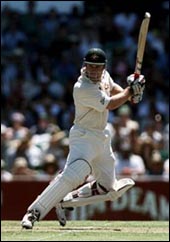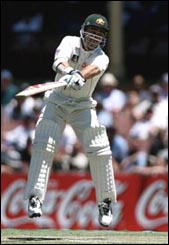How to beat the Aussies
Daniel Laidlaw
The following is a battle plan on the best way to bowl out Australia. Sourav
Ganguly and the Indian team hierarchy surely have their own ideas in place, but in case they missed something, here are some observations on the best methods of bowling to the Aussie batsmen and generally disrupting their game
plan...
General
According to Steve Waugh's latest book, Australia believes in the three Ps:
Patience, Pressure, and Partnerships. Therefore, it only makes sense that,
while still following their own strategy, the Indians do everything they
possibly can to interfere with Australia's 'P' priorities.
Patience: It is important to test the patience of Australia's batsmen,
particularly when the toursits may be going well. This means not releasing
the pressure, another of the Aussies' keywords, by bowling a 'four' ball at
the end of an accurate over. Pulling into a tight line outside off stump is
the perfect way to test the batsmen's patience, especially to players like
Slater who always look like they want to hit the ball.
For the fielders, high standards must be maintained throughout the whole day
- not lapsing and losing concentration in the last session.
Like all the best plans this is an exceedingly simple strategy, but
hopefully one that makes the batsmen become impatient and thus depart from
their policy.
 Pressure: From an Australian batting point of view, applying pressure to the
fielding team means attacking the bowling and scoring quickly, at about 3.5
runs per over. Bowlers under pressure become erratic, give the batsmen more
chances to score, and make the captain set defensive fields, enhancing the
batting team's position because the game is moving quickly.
Pressure: From an Australian batting point of view, applying pressure to the
fielding team means attacking the bowling and scoring quickly, at about 3.5
runs per over. Bowlers under pressure become erratic, give the batsmen more
chances to score, and make the captain set defensive fields, enhancing the
batting team's position because the game is moving quickly.
Pressure is applied to the fieldsmen by running sharply between the wickets,
keeping them on their toes and rotating the strike. Pressure is also picking
out the slower fielders or ones with weaker arms and turning singles into
twos against these players. Generally, batting with urgency places the
fielding team under pressure and throws them off their game.
So, it would benefit India to counteract this and throw the pressure back on
Australia. Composed, intelligent bowling is the key - recognising what is
happening and remedying it, according to the batsman. Slater playing the
pull shot too much? Pitch it up more. Mark Waugh scoring too many runs to
the leg side? Shift the line to outside off. Ponting sweeping too well?
Adjust the field for it. Making life uncomfortable for the batsmen is always
the best form of pressure.
In the field, it means remaining alert and not conceding those singles and
allowing ones to turn into twos. Athletic fielding that cuts off
opportunities is a good way of showing the batting team you are committed
and that runs will not come easily for them.
Partnerships: The final 'P' word, Partnerships, is the foundation of
batting. For Australia, it's not one individual who sets up an innings but
rather a large partnership. That is the basis of their batting. Somewhere
along the line, two players will usually combine to set up a total of 350
plus.
Saying breaking partnerships is important is like stating it's necessary to
take wickets or score more runs than the other team. However, there are a
couple of finer points to notice. What damages a batting team more than
anything, and what Australia strives to avoid, is losing wickets in quick
succession. It certainly hurt West Indies this season.
After a wicket is lost, establishing another partnership is the key to
taking away momentum from the bowling team. Therefore, taking wickets in
bunches will help deflate the Australian batting. When they're bowling, the
Aussies know this. Watch how they usually intimidate a new batsman at the
crease to try to turn one breakthrough into a succession of wickets. This
prevents the building of partnerships, or at least stops a new pair from
flourishing immediately after a wicket has fallen.
Dominating a session with a flurry of wickets is the way to demoralise the
Aussies. They will fight back, though, so do not relent - keep it up, break
partnerships, then capitalise on it with another wicket when it happens.
The batsmen: How to get them out
 Michael Slater: Australia's most positive batsman. Usually gets out early or
goes on to a big score. Fidgety early in his innings and prone to nicking
the ball. Keep it on a good length outside off and wait for him to play at
the wrong one for an edge to slips. Either that, or wait for him to get into
the nineties and throw it away himself! Will get down the pitch with quick
footwork against spin.
Michael Slater: Australia's most positive batsman. Usually gets out early or
goes on to a big score. Fidgety early in his innings and prone to nicking
the ball. Keep it on a good length outside off and wait for him to play at
the wrong one for an edge to slips. Either that, or wait for him to get into
the nineties and throw it away himself! Will get down the pitch with quick
footwork against spin.
Matthew Hayden: Struggled towards end of West Indies series and is lacking
form. Keep it that way. Has been dismissed several times in career not
playing a shot to ball coming into him from around the wicket. Test his
judgement outside off. Does not run well with the jumpy Slater, so look for
run out opportunities. Otherwise is a solid opener who likes the pull shot.
Justin Langer: Playing aggressively of late has been his downfall. Has been
out playing the cut shot so continue giving him deliveries to cut and wait
for the edge behind. Struggled enormously in Sri Lanka against the ball
turning away from the bat. Target him with off-spin.
Mark Waugh: Experienced and back in form. Plays spin adeptly but also gets
out to it a lot. Will take on the flighted ball. Test his patience with spin
and await a mistake. Doesn't play the pull shot so could be unsettled by
pitching short. Srinath and Agarkar can get him caught in slips driving at
deliveries that move away.
 Steve Waugh: Plays back early before he gets settled. Pitch it full just
outside off to get the edge behind as he plays back in defence. Similarly,
could be susceptible to lbw on the back foot. Learnt the slog-sweep on last
tour of India after watching Tendulkar and will use it occasionally to
alleviate pressure against the spinners.
Steve Waugh: Plays back early before he gets settled. Pitch it full just
outside off to get the edge behind as he plays back in defence. Similarly,
could be susceptible to lbw on the back foot. Learnt the slog-sweep on last
tour of India after watching Tendulkar and will use it occasionally to
alleviate pressure against the spinners.
Ricky Ponting: Plays aggressively from the outset and is possibly
Australia's best player of spin. Handled Muralitharan better than anyone on
last tour of subcontinent by using his feet and sweeping. Against pace,
tends to lunge onto front foot too much and can be caught in slips doing
this. Poor temperament. Stir him up.
Adam Gilchrist: Extremely dangerous. Can change the course of a match by
playing his natural game regardless of situation. His strength is also his
weakness so can be dismissed playing attacking shots. Hits in the air square
of the wicket and is a chance to be caught in the gully. Keeping it full or
spinning the ball away is best chance of success.
Glenn McGrath: King of No. 11s. Vulnerable against fast and spin bowlers
early, in the middle and late in his innings. Susceptible to all bowling and
can be dismissed by aiming at the stumps. Recently unveiled the pull shot.
Get the other guy out and he may not be so angry with ball in hand.
Mail Daniel Laidlaw